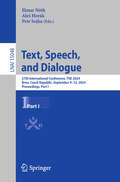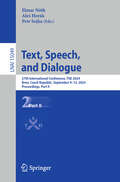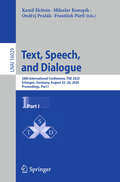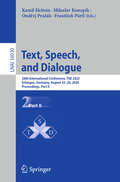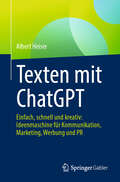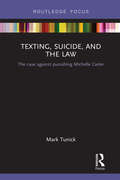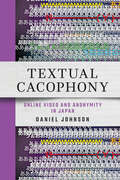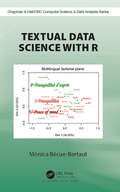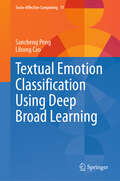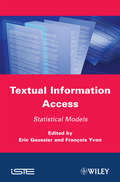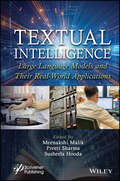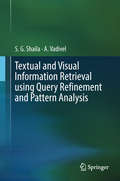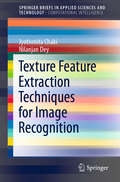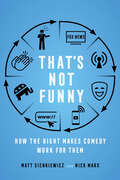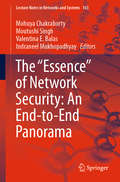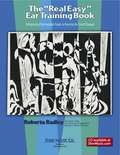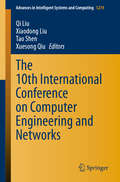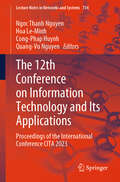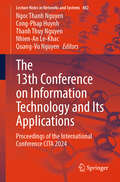- Table View
- List View
Text, Speech, and Dialogue: 27th International Conference, TSD 2024, Brno, Czech Republic, September 9–13, 2024, Proceedings, Part I (Lecture Notes in Computer Science #15048)
by Petr Sojka Aleš Horák Elmar NöthThe two-volume set LNAI 15048 and 15049 constitutes the refereed proceedings of the 27th International Conference on Text, Speech, and Dialogue, TSD 2024, held in Brno, Czech Republic, during September 9–13, 2024. The 50 revised full papers presented in these deadline proceedings were carefully reviewed and selected from 103 submissions. The papers are organized in the following topical sections: Part I: Text Part II: Speech, Dialogue
Text, Speech, and Dialogue: 27th International Conference, TSD 2024, Brno, Czech Republic, September 9–13, 2024, Proceedings, Part II (Lecture Notes in Computer Science #15049)
by Petr Sojka Aleš Horák Elmar NöthThe two-volume set LNAI 15048 and 15049 constitutes the refereed proceedings of the 27th International Conference on Text, Speech, and Dialogue, TSD 2024, held in Brno, Czech Republic, during September 9–13, 2024. The 50 revised full papers presented in these deadline proceedings were carefully reviewed and selected from 103 submissions. The papers are organized in the following topical sections: Part I: Text Part II: Speech, Dialogue
Text, Speech, and Dialogue: 28th International Conference, TSD 2025, Erlangen, Germany, August 25–28, 2025, Proceedings, Part I (Lecture Notes in Computer Science #16029)
by Kamil Ekštein František Pártl Miloslav Konopík Ondřej PražákThis conference volume constitutes the proceedings of the 28th International Conference on Engineering on Text, Speech, and Dialogue, TSD 2025, held in Erlangen, Germany, in August 2025. The 60 full papers were presented in this volume were carefully reviewed and selected from 122 submissions. They focus on speech and language technologies and computer processing of speech and language related data.
Text, Speech, and Dialogue: 28th International Conference, TSD 2025, Erlangen, Germany, August 25–28, 2025, Proceedings, Part II (Lecture Notes in Computer Science #16030)
by Kamil Ekštein František Pártl Miloslav Konopík Ondřej PražákThis conference volume constitutes the proceedings of the 28th International Conference on Engineering on Text, Speech, and Dialogue, TSD 2025, held in Erlangen, Germany, in August 2025. The 60 full papers were presented in this volume were carefully reviewed and selected from 122 submissions. They focus on speech and language technologies and computer processing of speech and language related data.
TextMate How-to
by Chris Mears"TextMate How-to" address essential tasks through recipes to hit the ground running and get started with practical solutions to common questions This book is geared toward beginning and intermediate web developers and designers who want to expedite their coding. Though TextMate can also work very well as a plain text editor, some experience with a programming or scripting language whether it's HTML, CSS, PHP, or Ruby is helpful to understand the depth to some of the examples provided.
Texten mit ChatGPT: Einfach, schnell und kreativ: Ideenmaschine für Kommunikation, Marketing, Werbung und PR
by Albert HeiserIn diesem Buch zeigt Albert Heiser – mehrfach ausgezeichneter Werbetexter – wie GPT-Programme zur Entwicklung wirkungsvoller und auch kreativer Texte in Werbung, Marketing und Kommunikation genutzt werden können. Texten mit Chatbots ist nicht neu, aber können GPT-Programme auch kreative und ansprechende Texte für Marketing, Werbung und Unternehmenskommunikation erstellen? Der Autor hat dies umfassend mit ChatGPT getestet und ebenfalls mit Neuroflash, Perplexity und Gemini verglichen. In seinem Buch zeigt er anhand der vielfältigen Textstrukturen im Marketing (von der Headline bis zum Call to Action), wie Chatbots als Brainstorming-Partner genutzt werden können. Zudem vermittelt er klare Qualitätskriterien für die Beurteilung von Texten – Kriterien, mit denen zielsicher Korrekturen an den KI-Texten gelingen. Das Verständnis für einen guten Schreibstil und die Wirkung der Gestaltung stehen dabei im Mittelpunkt. Dieses Buch bietet einen stilistischen Qualitäts- und Kreativcheck sowie eine Anleitung zum Prompten für Werbung, Marketing und Kommunikation, wie zum Beispiel für Headlines, Zwischenüberschriften, Imagetexte, Anzeigentexte, Produktbeschreibungen, Broschüren, Flyer, Mailings, Newsletter, Blogbeiträge, Social-Media-Posts, Teaser-Texte, Banner, Internetseiten und PR-Mitteilungen. Damit werden GPT-Programme zu einem wirkungsvollen Tool im Werkzeugkasten von Werbetextern, Autoren, Redakteuren und Content Managern. Der Inhalt So funktionieren GPT-Programme – darauf muss man achten Prompt-Engineering für Marketing, Werbung und Kommunikation: von der Headline bis zum Call to Action Prompts für längere Texte: von der Einleitung bis zum Fazit Die stilistische Qualität der Texte mit GPT prüfen und optimieren Der kreative Prompt Aktueller Stand zu Urheber- und Nutzungsrechten
Texting, Suicide, and the Law: The case against punishing Michelle Carter
by Mark TunickIn 2014, Conrad Roy committed suicide following encouragement from his long-distance girlfriend, Michelle Carter, in what has become known as the Texting Suicide case. The case has attracted much attention, largely focusing on the First Amendment free speech issue. This book takes the view that the issue is intertwined with several others, some of which have received less attention but help explain why the case is so captivating and important, issues concerning privacy, accountability, coercion, punishment, and assisted suicide. The focus here is on how all of these issues are interconnected. By breaking the issue down into its complex layers, the work aids reasoned judgment, ensuring we aren’t guided solely by our gut reactions. The book is laid out as a case against punishing Ms. Carter, but it is less important that we agree with that conclusion than that we reach our conclusions not just through our instincts and intuitions but by thinking about these fundamental issues. The work will be of interest to scholars in law, political theory, and philosophy as an example of how theoretical issues apply to particular controversies. It will also appeal to readers interested in freedom of speech and the First Amendment, criminal justice and theories of punishment, suicide laws, and privacy.
Textual Cacophony: Online Video and Anonymity in Japan
by Daniel JohnsonTextual Cacophony explores the behaviors and routines of communication within anonymous internet culture in Japan. Focusing on the video sharing website Niconico, social media aggregation sites, and the notorious 2channel message board, Daniel Johnson uncovers these sites' complex cultures of writing that obscure meaning through playful and opaque forms of deviant script and overwhelming waves of text. Those practices conflate language with images, meaning with play, and confound individual representation with aggregate forms of social identity. Johnson argues that online media cultures in and around Japan are entwined with a cultural logic and visual syntax of cacophony that expresses ambivalence toward representation, media form, and distinct experiences of time. This aesthetic of cacophony provides an alternative way of expressing social identity and belonging, with an unmarked sense of anonymity providing a counter-form to the dissolving institutions and relationships of neoliberal Japan. Textual Cacophony investigates what it means and feels like to participate in this influential online culture.
Textual Data Science with R (Chapman & Hall/CRC Computer Science & Data Analysis)
by Mónica Bécue-BertautTextual Statistics with R comprehensively covers the main multidimensional methods in textual statistics supported by a specially-written package in R. Methods discussed include correspondence analysis, clustering, and multiple factor analysis for contigency tables. Each method is illuminated by applications. The book is aimed at researchers and students in statistics, social sciences, hiistory, literature and linguistics. The book will be of interest to anyone from practitioners needing to extract information from texts to students in the field of massive data, where the ability to process textual data is becoming essential.
Textual Emotion Classification Using Deep Broad Learning (Socio-Affective Computing #11)
by Sancheng Peng Lihong CaoIn this book, the authors systematically and comprehensively discuss textual emotion classification by using deep broad learning. Since broad learning possesses certain advantages such as simple network structure, short training time and strong generalization ability, it is a new and promising framework for textual emotion classification in artificial intelligence. As a result, how to combine deep and broad learning has become a new trend of textual emotion classification, a booming topic in both academia and industry. For a better understanding, both quantitative and qualitative results are present in figures, tables, or other suitable formats to give the readers the broad picture of this topic along with unique insights of common sense and technical details, and to pave a solid ground for their forthcoming research or industry applications. In a progressive manner, the readers will gain exclusive knowledge in textual emotion classification using deep broad learning and be inspired to further investigate this underexplored domain. With no other similar book existing in the literature, the authors aim to make the book self-contained for newcomers, only a few prerequisites being expected from the readers. The book is meant as a reference for senior undergraduates, postgraduates, scientists and researchers interested to have a quick idea of the foundations and research progress of security and privacy in federated learning, and it can equally well be used as a textbook by lecturers, tutors, and undergraduates.
Textual Information Access: Statistical Models (Wiley-iste Ser. #588)
by Eric Gaussier François YvonThis book presents statistical models that have recently been developed within several research communities to access information contained in text collections. The problems considered are linked to applications aiming at facilitating information access: - information extraction and retrieval; - text classification and clustering; - opinion mining; - comprehension aids (automatic summarization, machine translation, visualization). In order to give the reader as complete a description as possible, the focus is placed on the probability models used in the applications concerned, by highlighting the relationship between models and applications and by illustrating the behavior of each model on real collections. Textual Information Access is organized around four themes: informational retrieval and ranking models, classification and clustering (regression logistics, kernel methods, Markov fields, etc.), multilingualism and machine translation, and emerging applications such as information exploration. Contents Part 1: Information Retrieval 1. Probabilistic Models for Information Retrieval, Stéphane Clinchant and Eric Gaussier. 2. Learnable Ranking Models for Automatic Text Summarization and Information Retrieval, Massih-Réza Amini, David Buffoni, Patrick Gallinari, Tuong Vinh Truong and Nicolas Usunier. Part 2: Classification and Clustering 3. Logistic Regression and Text Classification, Sujeevan Aseervatham, Eric Gaussier, Anestis Antoniadis, Michel Burlet and Yves Denneulin. 4. Kernel Methods for Textual Information Access, Jean-Michel Renders. 5. Topic-Based Generative Models for Text Information Access, Jean-Cédric Chappelier. 6. Conditional Random Fields for Information Extraction, Isabelle Tellier and Marc Tommasi. Part 3: Multilingualism 7. Statistical Methods for Machine Translation, Alexandre Allauzen and François Yvon. Part 4: Emerging Applications 8. Information Mining: Methods and Interfaces for Accessing Complex Information, Josiane Mothe, Kurt Englmeier and Fionn Murtagh. 9. Opinion Detection as a Topic Classification Problem, Juan-Manuel Torres-Moreno, Marc El-Bèze, Patrice Bellot and Fréderic Béchet.
Textual Intelligence: Large Language Models and Their Real-World Applications
by Susheela Hooda Meenakshi Malik Preeti SharmaThe book is a must-have resource for anyone looking to understand the complexities of generative AI, offering comprehensive insights into LLMs, effective training strategies, and practical applications. Textual Intelligence: Large Language Models and Their Real-World Applications provides an overview of generative AI and its multifaceted applications, as well as the significance and potential of Large Language Models (LLMs), including GPT and LLaMA. It addresses the generative AI project lifecycle, challenges in existing data architectures, proposed use case planning and scope definition, model deployment, and application integration. Training LLMs, data requirements for effective LLM training, pre-training and fine-tuning processes, and navigating computational resources and infrastructure are also discussed. The volume delves into in-context learning and prompt engineering, offering strategies for crafting effective prompts, techniques for controlling model behavior and output quality, and best practices for prompt engineering. Textual Intelligence: Large Language Models and Their Real-World Applications also discusses cost optimization strategies for LLM training, aligning models to human values, optimizing model architectures, the power of transfer learning and fine-tuning, instruction fine-tuning for precision, and parameter-efficient fine-tuning (PEFT) with adapters such as LoRA, QLoRA, and soft prompts, making it an essential guide for both beginners and industry veterans. Readers will find this book: Explores the real-world potential of large language models; Introduces industry-changing AI solutions; Provides advanced insights on AI and its models. Audience Industry professionals, academics, graduate students, and researchers seeking real-world solutions using generative AI.
Textual and Visual Information Retrieval using Query Refinement and Pattern Analysis
by S. G. Shaila A VadivelThis book offers comprehensive coverage of information retrieval by considering both Text Based Information Retrieval (TBIR) and Content Based Image Retrieval (CBIR), together with new research topics. The approach to TBIR is based on creating a thesaurus, as well as event classification and detection. N-gram thesaurus generation for query refinement offers a new method for improving the precision of retrieval, while event classification and detection approaches aid in the classification and organization of information using web documents for domain-specific retrieval applications. In turn, with regard to content based image retrieval (CBIR) the book presents a histogram construction method, which is based on human visual perceptions of color. The book’s overarching goal is to introduce readers to new ideas in an easy-to-follow manner.
Texture Feature Extraction Techniques for Image Recognition (SpringerBriefs in Applied Sciences and Technology)
by Nilanjan Dey Jyotismita ChakiThe book describes various texture feature extraction approaches and texture analysis applications. It introduces and discusses the importance of texture features, and describes various types of texture features like statistical, structural, signal-processed and model-based. It also covers applications related to texture features, such as facial imaging. It is a valuable resource for machine vision researchers and practitioners in different application areas.
Texture Spaces (Studies in Fuzziness and Soft Computing #411)
by Murat DikerThis book provides a complete framework for the fundamental concepts and results of texture spaces and its applications. The principal aim is to present a comprehensive arguments due to connections among the textures, fuzzy sets and rough sets. In this context, direlations, fuzzy direlations and fuzzy relations constitute a bridge for the remarkable observations on rough set theory. In a more general setting, the approximation operators are also inspected for fuzzy rough set models with two domains of discourse. Since the book is self-contained and reader-friendly, the respected researchers may utilize this source for further investigations of the necessary results for their studies on rough set theory using textures. Therefore, prospective readers are not only mathematicians who interest in purely mathematical theories related to textures, but also engineers of information sciences who need more information for their interdisciplinary studies with respect to rough sets and fuzzy sets.
That Used to Be Us: How America Fell Behind in the World It Invented and How We Can Come Back
by Thomas L. Friedman Michael MandelbaumAmerica is in trouble. We face four major challenges on which our future depends, and we are failing to meet them -- and if we delay any longer, soon it will be too late for us to pass along the American dream to future generations. In That Used to Be Us, Thomas L. Friedman, one of our most influential columnists, and Michael Mandelbaum, one of our leading foreign policy thinkers, offer both a wake-up call and a call to collective action. They analyze the four challenges we face -- globalization, the revolution in information technology, the nation's chronic deficits, and our pattern of excessive energy consumption -- and spell out what we need to do now to sustain the American dream and preserve American power in the world. They explain how the end of the Cold War blinded the nation to the need to address these issues seriously, and how China's educational successes, industrial might, and technological prowess remind us of the ways in which "that used to be us. " They explain how the paralysis of our political system and the erosion of key American values have made it impossible for us to carry out the policies the country urgently needs. And yet Friedman and Mandelbaum believe that the recovery of American greatness is within reach. They show how America's history, when properly understood, offers a five-part formula for prosperity that will enable us to cope successfully with the challenges we face. They offer vivid profiles of individuals who have not lost sight of the American habits of bold thought and dramatic action. They propose a clear way out of the trap into which the country has fallen, a way that includes the rediscovery of some of our most vital traditions and the creation of a new thirdparty movement to galvanize the country. That Used to Be Us is both a searching exploration of the American condition today and a rousing manifesto for American renewal.
That's Not Funny: How the Right Makes Comedy Work for Them
by Matt SienkiewiczA rousing call for liberals and progressives to pay attention to the emergence of right-wing comedy and the political power of humor. "Why do conservatives hate comedy? Why is there no right-wing Jon Stewart?" These sorts of questions launch a million tweets, a thousand op-eds, and more than a few scholarly analyses. That's Not Funny argues that it is both an intellectual and politically strategic mistake to assume that comedy has a liberal bias. Matt Sienkiewicz and Nick Marx take readers––particularly self-described liberals––on a tour of contemporary conservative comedy and the "right-wing comedy complex." In That's Not Funny, "complex" takes on an important double meaning. On the one hand, liberals have developed a social-psychological complex—it feels difficult, even dangerous, to acknowledge that their political opposition can produce comedy. At the same time, the right has been slowly building up a comedy-industrial complex, utilizing the humorous, irony-laden media strategies of liberals such as Jon Stewart, Samantha Bee, and John Oliver to garner audiences and supporters. Right-wing comedy has been hiding in plain sight, finding its way into mainstream conservative media through figures ranging from Fox News's Greg Gutfeld to libertarian podcasters like Joe Rogan. That's Not Funny taps interviews with conservative comedians and observations of them in action to guide readers through media history, text, and technique. You will find many of these comedians utterly appalling, some surprisingly funny, and others just plain weird. They are all, however, culturally and politically relevant—the American right is attempting to seize spaces of comedy and irony previously held firmly by the left. You might not like this brand of humor, but you can't ignore it.
The "Essence" of Network Security: An End-to-End Panorama (Lecture Notes in Networks and Systems #163)
by Valentina E. Balas Mohuya Chakraborty Moutushi Singh Indraneel MukhopadhyayThis edited book provides an optimal portrayal of the principles and applications related to network security. The book is thematically divided into five segments: Part A describes the introductory issues related to network security with some concepts of cutting-edge technologies; Part B builds from there and exposes the readers to the digital, cloud and IoT forensics; Part C presents readers with blockchain and cryptography techniques; Part D deals with the role of AI and machine learning in the context of network security. And lastly, Part E is written on different security networking methodologies. This is a great book on network security, which has lucid and well-planned chapters. All the latest security technologies are thoroughly explained with upcoming research issues. Details on Internet architecture, security needs, encryption, cryptography along with the usages of machine learning and artificial intelligence for network security are presented in a single cover. The broad-ranging text/reference comprehensively surveys network security concepts, methods, and practices and covers network security policies and goals in an integrated manner. It is an essential security resource for practitioners in networks and professionals who develop and maintain secure computer networks.
The "Real Easy" Ear Training Book
by Sher Music Roberta RadleyAll great musicians have one thing in common---to a great extent they know what the harmony of a song is as they hear it. Do you? If not, here is a practical guide to get you up to speed. Written by Berklee professor Roberta Radley, it uses contemporary music to help you see how ear training is invaluable for your own musical needs.
The 100% Official Piggy Survival Manual: An AFK Book
by ScholasticFans will not want to miss the very first official guide to PIGGY! Full of tips, tricks, lore, and more, this guide has everything you need to survive!Make it out alive with the official Piggy Survival Manual! This handbook includes everything you need to survive in the terror-filled world of PIGGY! Uncover secrets, master every book and chapter, and learn all there is to know about the world and characters of PIGGY.
The 10th International Conference on Computer Engineering and Networks (Advances in Intelligent Systems and Computing #1274)
by Xuesong Qiu Qi Liu Xiaodong Liu Tao ShenThis book contains a collection of the papers accepted by the CENet2020 – the 10th International Conference on Computer Engineering and Networks held on October 16-18, 2020 in Xi’an, China. The topics focus but are not limited to Internet of Things and Smart Systems, Artificial Intelligence and Applications, Communication System Detection, Analysis and Application, and Medical Engineering and Information Systems. Each part can be used as an excellent reference by industry practitioners, university faculties, research fellows and undergraduates as well as graduate students who need to build a knowledge base of the most current advances and state-of-practice in the topics covered by this conference proceedings. This will enable them to produce, maintain, and manage systems with high levels of trustworthiness and complexity.
The 11th International Conference on EUropean Transnational Educational (Advances in Intelligent Systems and Computing #1266)
by Álvaro Herrero Javier Sedano Héctor Quintián Emilio Corchado Daniel Urda Carlos CambraThis book contains accepted papers presented at ICEUTE 2020 held in the beautiful and historic city of Burgos (Spain), in September 2020.The 11th International Conference on EUropean Transnational Education (ICEUTE 2020) has been a meeting point for people working on transnational education within Europe. It has provided a stimulating and fruitful forum for presenting and discussing the latest works and advances on transnational education within European countries.After a thorough peer-review process, the ICEUTE 2020 International Program Committee selected 44 papers which are published in these conference proceedings achieving an acceptance rate of 41%. Due to the COVID-19 outbreak, the ICEUTE 2020 edition was blended, combining on-site and on-line participation. In this relevant edition, a special emphasis was put on the organization of five special sessions related to relevant topics as Role of English in Transnational Education and Teacher Training, Personalization and ICT: a Path to Educational Inclusion, Innovation and Research Findings in Engineering Higher Education, Practical Implementations of Novel Initiatives, and Innovation in Computer Science Higher Education.The selection of papers was extremely rigorous in order to maintain the high quality of the conference, and we would like to thank the members of the Program Committees for their hard work in the reviewing process. This is a crucial process to the creation of a high standard conference, and the ICEUTE conference would not exist without their help.
The 12th Conference on Information Technology and Its Applications: Proceedings of the International Conference CITA 2023 (Lecture Notes in Networks and Systems #734)
by Ngoc Thanh Nguyen Hoa Le-Minh Cong-Phap Huynh Quang-Vu NguyenThis book constitutes the refereed proceedings of the 12th Conference on Information Technology and its Applications, CITA 2023, taking place on July 28-29, 2023 in Da Nang City, the most beautiful and livable city in Vietnam. CITA is an annual scientific conference on information technology and its applications in all fields. The main objective of the conference is to create a forum to gather and connect Vietnamese and international researchers, scientists in the fields of information technology and its applications. The book includes 33 papers, selected from 144 papers submitted to CITA 2023 whose authors come from over 20 countries around the world, which were carefully reviewed by at least two members of the Program Committee, with professional advice from reputable scientists in the field of information technology and technology, digital economy such as Prof. Dr.Sc. Ngoc-Thanh Nguyen (Poland), Prof. Dr. Dosam Hwang (Korea), Assoc. Prof. Dr. Le Minh Hoa (UK), and Prof.Dr. Nguyen Thanh Thuy (Vietnam). The acceptance rate of CITA 2023 is about 24%. The papers in the book are organized in the following topical sections: Data Science and Artificial Intelligence; Image and Natural Language Processing; Software Engineering and Information Systems; Network and Communications; and Digital Economy. The accepted and presented papers focus on new trends and challenges facing the information and communication technology as well as digital economy community. If you are scientists, lecturers, doctoral students, we hope that you will find many useful and good quality results from the book for your future research.
The 13th Conference on Information Technology and Its Applications: Proceedings of the International Conference CITA 2024 (Lecture Notes in Networks and Systems #882)
by Ngoc Thanh Nguyen Nhien-An Le-Khac Cong-Phap Huynh Quang-Vu Nguyen Thanh Thuy NguyenThis book presents selected papers from the 13th International Conference on Information Technology and its Applications (CITA 2024) which took place on July 19–20, 2024. The 13th CITA will be hosted by the Vietnam-Korea University of Information and Communication Technology (VKU), a member of University of Danang, with the supports of the researching and training institutions belonging to ASEAN Consortium for Innovation and Research (ACIR) as well as Vietnam ICT Association of Faculties-Institutes-School-Universities (FISU Vietnam). The conference will take place in Da Nang City and Hoi An City which are beautiful and livable cities in Vietnam. All papers submitted to CITA 2024 are reviewed seriously, closely, and thoroughly by 02-04 reviewers with appropriate expertise, with professional advice from reputable scientists in the fields of information and communication technology. Over the past 13 years of establishment and development, CITA has become an international scientific conference with a prestigious brand in the scientific community not only in Vietnam but also around the world in the field of ICT and digital economy. For this edition of the conference, we have received in total 173 papers whose authors come from over 25 countries around the world. Only 43 papers of the highest quality were selected for oral presentation and publication in this LNNS volume. The average rate of papers accepted by this volume is about 25%. Papers included in these proceedings cover the following topics: data science and artificial intelligence, image and natural language processing, software engineering and information system, network and communications, and digital economy. The accepted and presented papers focus on new trends and challenges facing information technology and its applications. The presenters show how research works can stimulate novel and innovative applications. We hope that you find these results useful and inspiring for your future research work.
The 17th International Conference Interdisciplinarity in Engineering: Inter-Eng 2023 Conference Proceedings - Volume 1 (Lecture Notes in Networks and Systems #926)
by Liviu Moldovan Adrian GligorThis book contains research papers that were accepted for presentation at the 17th International Conference on Interdisciplinarity in Engineering—INTER-ENG 2023, which was held on 5–6 October 2023, in the city of Târgu Mureș, Romania. The general scope of the conference “Towards transition for a more competitive European industry in a smart, safe and sustainable future” is proposing a new approach related to the development of a new generation of smart factories grounded on the manufacturing and assembly process digitalization. It is related to advance manufacturing technology, lean manufacturing, sustainable manufacturing, additive manufacturing, manufacturing tools and equipment. It is a leading international professional and scientific forum of great interest for engineers and scientists who can read in this book research works contributions and recent developments as well as current practices in advanced fields of engineering.
